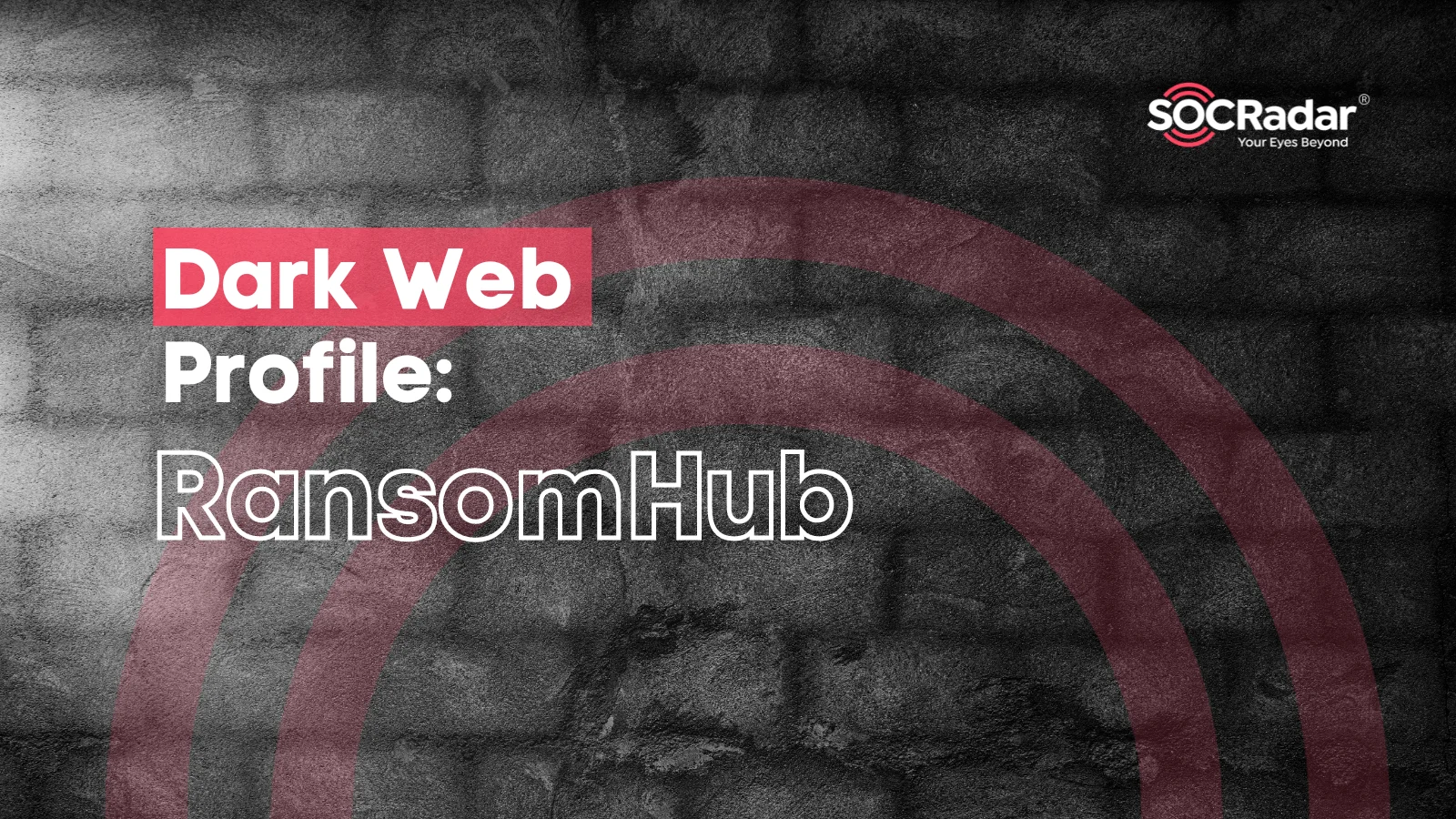
Threat intelligence enriched with External Attack Surface Management, Brand Protection, and Dark Web Radar.
Protect your business from the dangers lurking in the hidden corners of the internet.
Effective threat hunting and threat actor tracking with behavioral analytics.
Discover your assets with a hacker mindset.
Stay ahead of threat actors with actionable intelligence alerts.
Evaluate the security posture of your entire supply network.
Your guide in harnessing the full potential of our platform.
Hear SOCRadar’s impressive achievements from our clients.
Automate and operationalize your security operations.
Consulting and professional services for cybersecurity excellence.
Industry, sector, and region-based in-depth research.
Discover the heartbeat of cyberspace through a collection showcasing the latest incidents.
Discover how XTI empowers organizations to proactively identify, mitigate, and respond to evolving cyber threats.
Register for our live webinars, and watch our on-demand webinars instantly.
Dive deep into the world of cyber threats, advanced analysis techniques, and cutting-edge strategies.
Stay informed and up-to-date on the latest cybersecurity trends.
Explore SOCRadar’s learning experience to fuel your cybersecurity journey with insights that exceed industry standards.
We offer expert-led, and exclusive trainings to help you master the latest in cybersecurity, trusted by over 2,000 top companies.
Scan the dark web to prevent your leaks from turning into real risks.
Instantly access dark web findings about your organization’s assets.
Check if there is anything about you in SOCRadar’s ever-expanding breach database.
Track threat actors and groups by country or industry for effective follow-up.
Explore threat actors’ tactics, techniques, activities, and detailed profiles targeting your industry or region.
All-in-one next-generation tools for investigating everyday events like phishing, malware, account breach, etc.
Power your search with SOCRadar’s IOC Radar.
Let’s get to know each other better.
Broaden your market reach and increase ARR with SOCRadar Extended Threat Intelligence.
Get informed of our upcoming events.
Latest news about our platform, company, and what’s being said about us.
Begin an extraordinary journey in your professional path with SOCRadar.
We’d like to hear from you.
SOCRadar Training Series – Mastering AI in Cybersecurity From Theory to Practice
Resources
[Update] June 6, 2024: “RansomHub Adds ZeroLogon Vulnerability to Its Arsenal”
[Update] April 8, 2024: “From ALPHV to RansomHub: Change Healthcare”
A new threat actor has emerged in the ransomware landscape, distinguishing themselves by making claims and backing them up with data leaks. In February 2024, RansomHub posted its first victim, the Brazilian company YKP. Since then, they have made 17 additional claims, although their leak site currently lists only 14 victims.
RansomHub’s logo on their leak site’s main page
As stated on the group’s About page, RansomHub comprises hackers from various global locations united by a common goal of financial gain. The gang explicitly mentions prohibiting attacks on specific countries and non-profit organizations.
RansomHub’s “About” page
The gang’s website states that they refrain from targeting CIS, Cuba, North Korea, and China. While they suggest a global hacker community, their operations notably resemble a traditional Russian ransomware setup. Their stance on Russian-affiliated nations and the overlap in targeted companies with other Russian ransomware groups are also worth noting.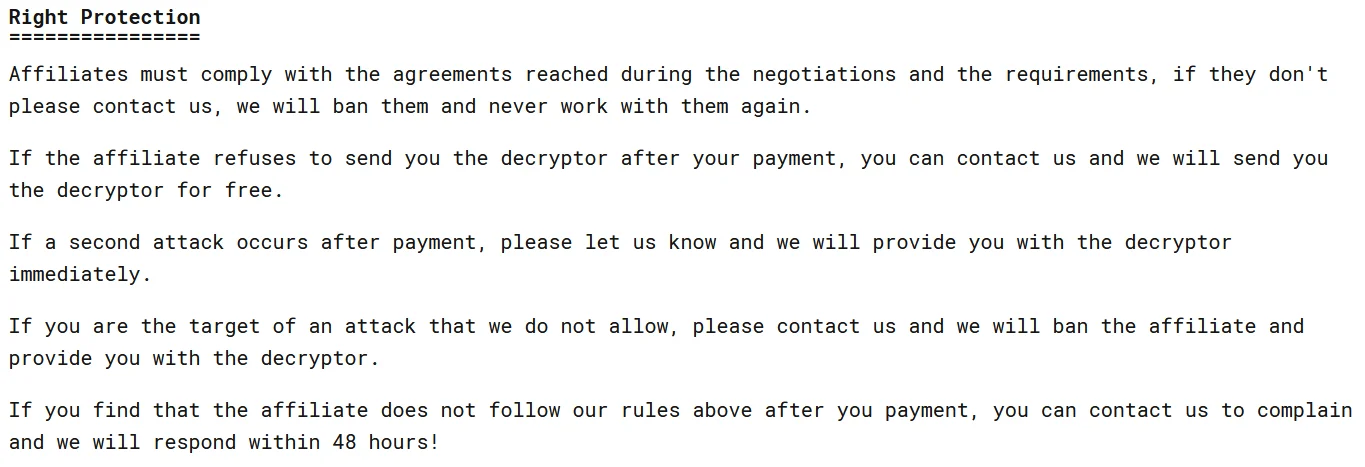
RansomHub’s “About” page-2
The “Right Protection” segment on their About page delineates guidelines for affiliates and underscores the importance of “conscientiousness.” This section also discloses that RansomHub functions as a ransomware group in collaboration with affiliates, thus we can classify it as a Ransomware-as-a-Service (RaaS) group.
RansomHub asserts that affiliates must adhere to the agreements and requirements set during negotiations, warning that failure to do so will result in a ban and termination of collaboration.
Furthermore, they promise to provide victims with a free decryptor if the affiliate fails to do so after receiving payment or if an off-limits organization is targeted. Therefore, the group’s chosen ransomware is evidently capable of encrypting data before exfiltration.
The group tries to recruit its affiliates from the mostly Russian populated RAMP forum, and also states that its strains are ESXi rewritten in Golang.
There has been limited activity on the RAMP forum since May 3, indicating that they may have acquired a sufficient number of affiliates for the time being.
Affiliates receive 90% of the money, while the remaining 10% goes to the main group. In contrast to the common practice, the money is initially sent to the affiliate, a feature that is highly regarded in the ransomware community. This approach addresses the distrust caused by ALPHV’s $22 million scam, where affiliates were not compensated, leading to significant mistrust in the Ransomware-as-a-Service (RaaS) environment.
As Cyberdaily suggested, on their data leak site, it seems that the affiliates themselves handle the postings. How victims are listed varies, including differences in the presentation of evidence for each hack and the language used. Some posts link to a hosting service for sharing proof-of-hack documents, while others include screenshots directly in the leaked post.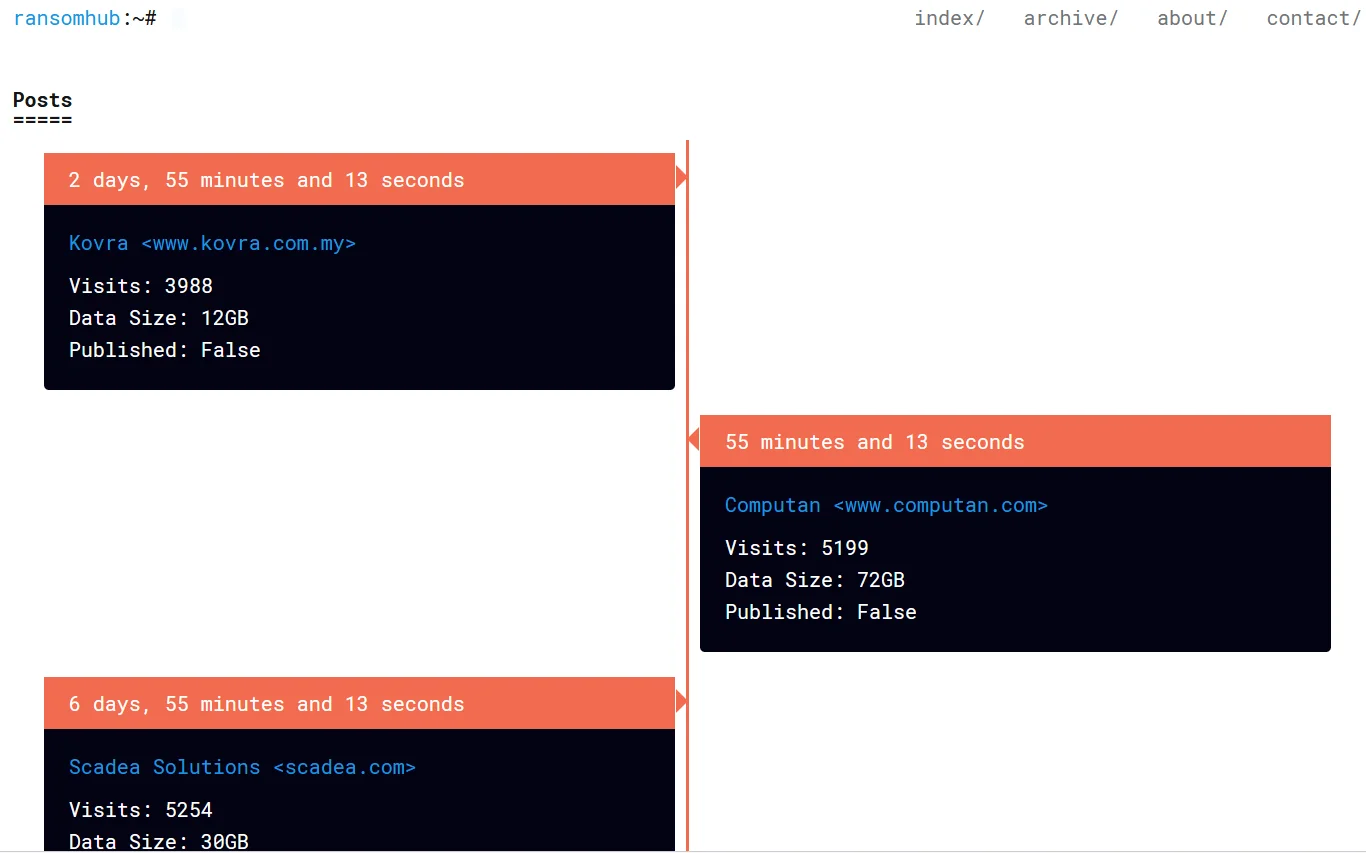
RansomHub’s victim listings
Threat actors are listing victims from various countries without following a specific pattern, targeting a diverse range of nations such as the US, Brazil, Indonesia, and Vietnam. While notably large companies have not appeared on the list so far, healthcare-related institutions, which are considered critical sectors, are among the listed victims.
Latest recorded victim is manufacturing company Kovra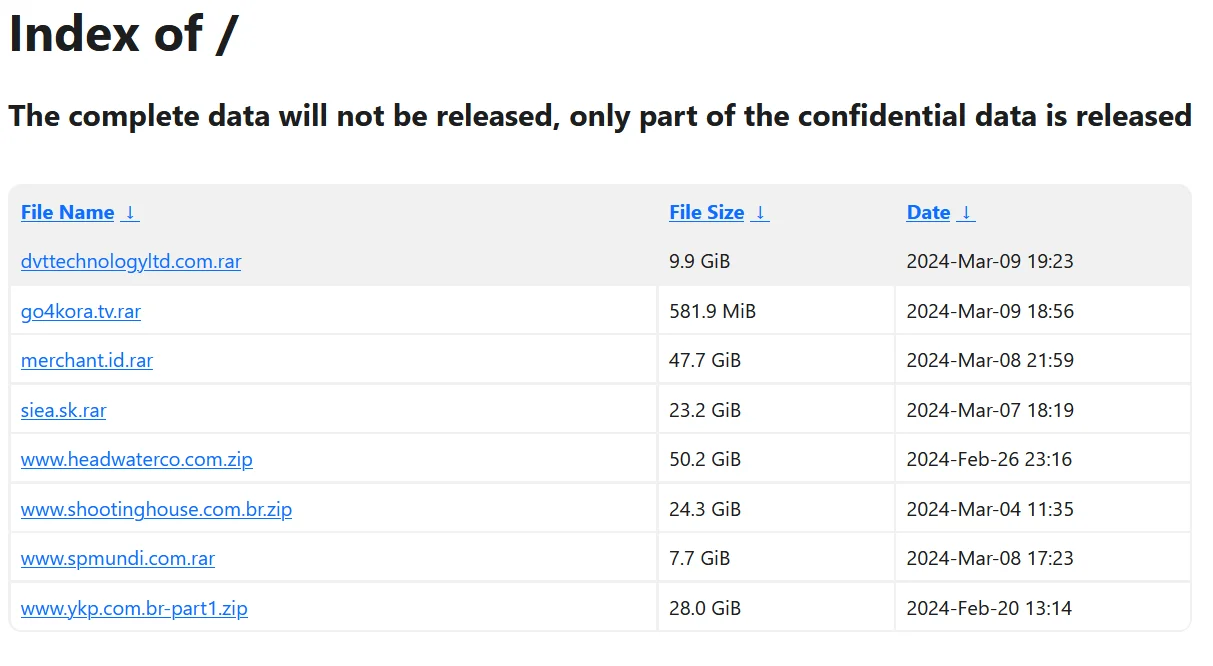
The RansomHub group also hosts sample data from victims from whom it could not receive payment, available for download on its website.
The RansomHub group seems to be a recently emerged ransomware group, likely with roots in Russia. Due to the benefits it offers its affiliates and the strict controls it enforces, they could be vying for the leadership position amidst pressure from security forces to major players like LockBit and ALPHV. However, their ransomware strains appear to be just a revised version of an old sample for now.
An interesting part is that this strain is also written in Golang language; GhostSec and GhostLocker ransomware, which recently attracted attention, also wrote their new versions in Golang language. Again, it may be a step that will shed light on future trends.
The RansomHub gang targeted two healthcare organizations, but the twist is that Change Healthcare, a company that had dealt with the ALPHV group before, is listed here again.
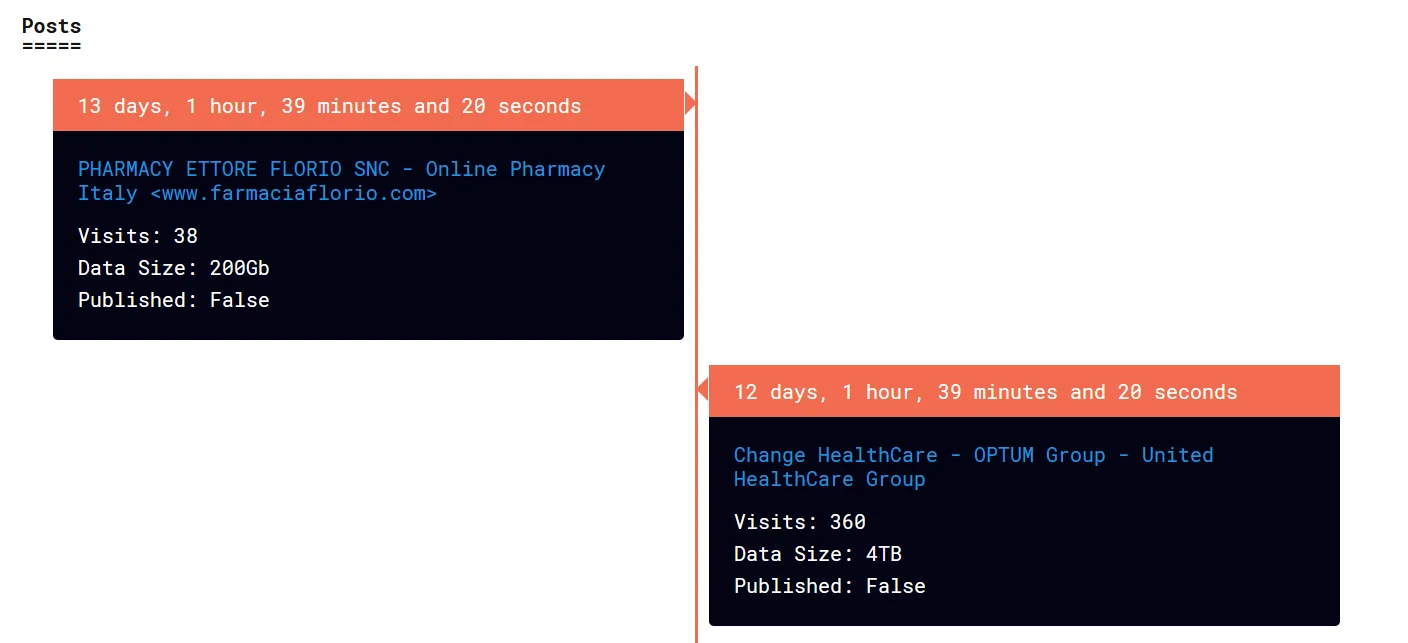
RansomHub’s latest victim listings
Change Healthcare got hit with ransomware before, allegedly by ALPHV. They say they didn’t pay, but the information found by researchers proved otherwise. It seems they shelled out around $22 million to get their data back. Later, when ALPHV got the money, they vanished without giving their partner the 80% cut they usually get. Practically, they made an exit scam.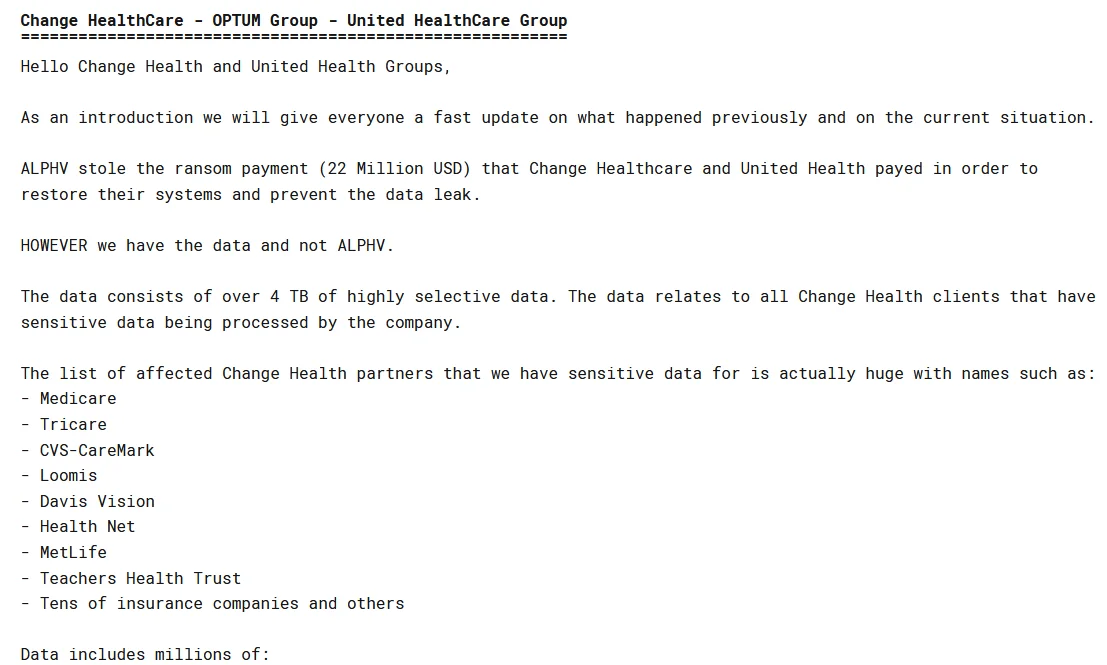
About United HealthCare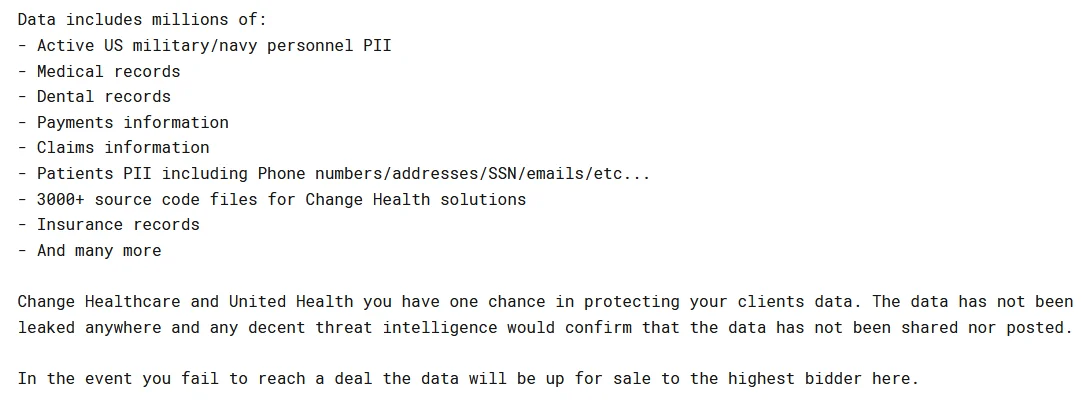
About United HealthCare – 2
Now, RansomHub is in the picture. They’ve listed Change Healthcare on their site and claim to have their data, hinting at another extortion attempt.
Some claims were made even as RansomHub is just a new name for ALPHV or they’re playing a trick to scare Change Healthcare into paying up again.
However, it is tough to say that RansomHub is a rebranding. First of all, the leak sites appeared before ALPHV’s scamming incident, and the group also claims to have its own strain and partners.
Of course, it is not surprising that ransomware operators originating from the Russian cybercrime landscape have relationships with each other so a connection is always possible. Thus, a higher possibility is that RansomHub may have acquired the former ALPHV affiliate as its own partner.
As we mentioned in our previous headings, they offered much better opportunities for affiliates than other groups, and we also said that it was possible for ALPHV and LockBit affiliates to move under the umbrella of this group.
Recent ransomware attacks by the RansomHub group have leveraged the old but critical ZeroLogon vulnerability: CVE-2020-1472 (CVSS: 10).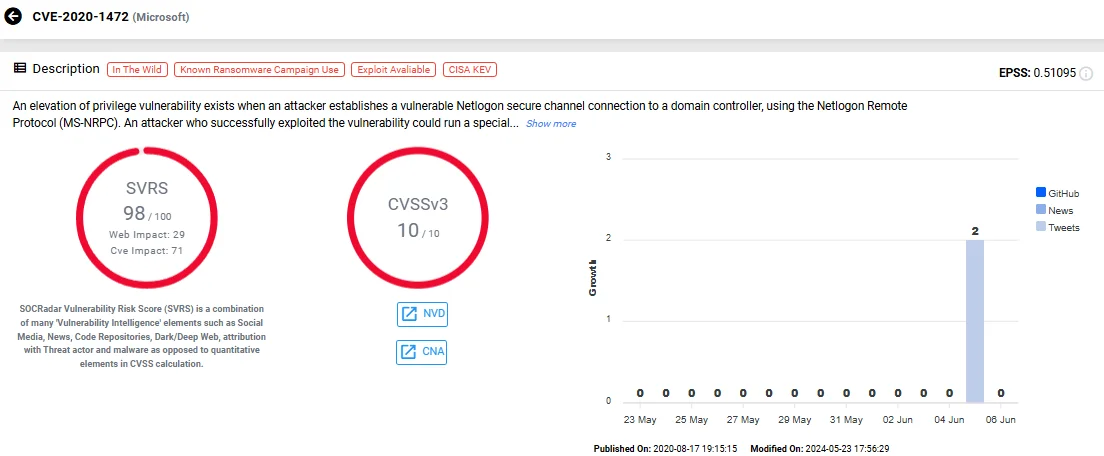
The ZeroLogon vulnerability, CVE-2020-1472 (SOCRadar’s Vulnerability Intelligence)
As one of the top 10 vulnerabilities used by ransomware actors, this flaw allows attackers to take over an organization’s domain controllers by establishing a vulnerable Netlogon secure channel connection. Successful exploitation enables an attacker to run specially crafted applications on network devices, obtaining domain administrator access.
Researchers report that in these attacks, RansomHub operators use tools like Atera and Splashtop for remote access and NetScan for network reconnaissance. Before deploying the ransomware, they use command-line tools such as iisreset[.]exe to stop all Internet Information Services (IIS) services.
Ransomware threat actors constantly evolve their tactics, discovering new ways or exploiting old vulnerabilities to infiltrate organizations. Organizations must patch these vulnerabilities to protect themselves from not only ransomware but all cyber threats.
Although it is valid to establish a defense approach against threat actors through specific TTPs and IoCs, emphasis should be placed on general ransomware defense strategies rather than such an intense focus on dozens or even hundreds of groups that are similar to each other.
Regular Data Backup: Implement a robust backup strategy to regularly back up critical data and ensure its availability for recovery in case of a ransomware attack.
Security Awareness Training: Educate employees about ransomware threats, phishing tactics, and cybersecurity best practices to reduce the risk of falling victim to malicious attacks.
Patch and Update Management: Keep operating systems, software, and applications up to date with the latest security patches and updates to address known vulnerabilities that could be exploited by ransomware.
Network Segmentation: Implement network segmentation to separate critical systems and sensitive data from less secure parts of the network, reducing the potential impact of ransomware infections.
Access Control: Restrict user privileges and access rights based on the principle of least privilege to minimize the attack surface and limit the spread of ransomware within the network.
Email and Web Security: Deploy advanced email filtering and web security solutions to detect and block malicious attachments, links, and phishing attempts that could deliver ransomware payloads.
Endpoint Protection: Use endpoint security solutions such as antivirus software, Intrusion Detection Systems (IDS), and Endpoint Detection and Response (EDR) tools to detect and mitigate ransomware threats on endpoints.
Incident Response Plan: Develop and regularly test an incident response plan specifically tailored to ransomware attacks. This plan should include procedures for identifying, containing, mitigating, and recovering from ransomware incidents.
Regular Security Audits: Conduct regular security audits, vulnerability assessments, and penetration testing to identify and remediate security gaps and weaknesses that could be exploited by ransomware attackers.
Backup Testing and Verification: Regularly test and verify backup data to ensure its integrity and usability for recovery purposes, and store backup copies securely to prevent unauthorized access.
By implementing these mitigation strategies, organizations can enhance their resilience against ransomware attacks and minimize the potential impact on their operations and data.
SOCRadar offers proactive threat monitoring and intelligence solutions designed to bolster your organization’s security posture. Through our platform, you gain the capability to proactively search for specific threat actors and obtain comprehensive insights into their tactics, targeted vulnerabilities, affiliations with other actors, and indicators of compromise. This empowers you to stay ahead of potential threats and take preemptive measures to protect your assets.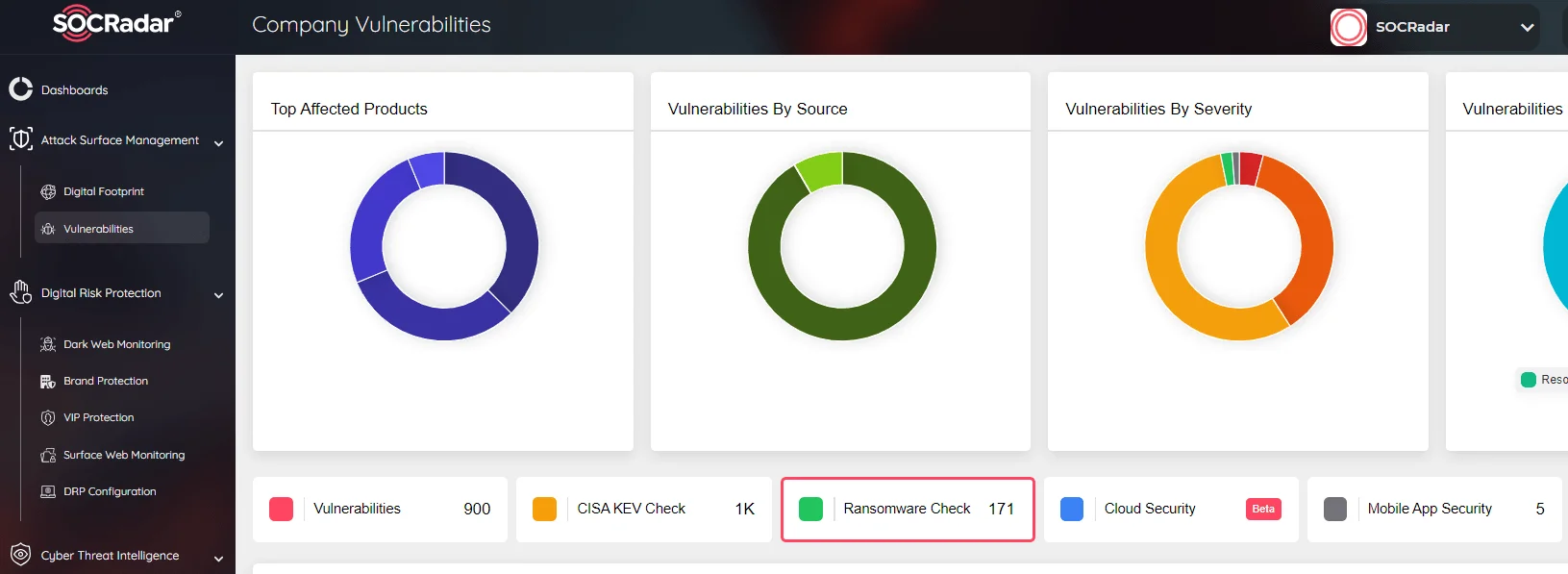
SOCRadar, Attack Surface Management Module with Ransomware Check function
Moreover, our Attack Surface Management module provides continuous monitoring of all potential attack vectors, ensuring that you receive timely alerts about any suspicious activity. This proactive approach enables you to swiftly respond to threats and strengthen your overall cybersecurity defenses.
Subscribe to our newsletter and stay updated on the latest insights!
PROTECTION OF PERSONAL DATA COOKIE POLICY FOR THE INTERNET SITE
Protecting your personal data is one of the core principles of our organization, SOCRadar, which operates the internet site (www.socradar.com). This Cookie Usage Policy (“Policy”) explains the types of cookies used and the conditions under which they are used to all website visitors and users.
Cookies are small text files stored on your computer or mobile device by the websites you visit.
Cookies are commonly used to provide you with a personalized experience while using a website, enhance the services offered, and improve your overall browsing experience, contributing to ease of use while navigating a website. If you prefer not to use cookies, you can delete or block them through your browser settings. However, please be aware that this may affect your usage of our website. Unless you change your cookie settings in your browser, we will assume that you accept the use of cookies on this site.
1. WHAT KIND OF DATA IS PROCESSED IN COOKIES?
Cookies on websites collect data related to your browsing and usage preferences on the device you use to visit the site, depending on their type. This data includes information about the pages you access, the services and products you explore, your preferred language choice, and other preferences.
2. WHAT ARE COOKIES AND WHAT ARE THEIR PURPOSES?
Cookies are small text files stored on your device or web server by the websites you visit through your browsers. These small text files, containing your preferred language and other settings, help us remember your preferences on your next visit and assist us in making improvements to our services to enhance your experience on the site. This way, you can have a better and more personalized user experience on your next visit.
The main purposes of using cookies on our Internet Site are as follows:
3. TYPES OF COOKIES USED ON OUR INTERNET SITE 3.1. Session Cookies
Session cookies ensure the smooth operation of the internet site during your visit. They are used for purposes such as ensuring the security and continuity of our sites and your visits. Session cookies are temporary cookies and are deleted when you close your browser; they are not permanent.
3.2. Persistent Cookies
These cookies are used to remember your preferences and are stored on your device through browsers. Persistent cookies remain stored on your device even after you close your browser or restart your computer. These cookies are stored in your browser’s subfolders until deleted from your browser’s settings. Some types of persistent cookies can be used to provide personalized recommendations based on your usage purposes.
With persistent cookies, when you revisit our website with the same device, the website checks if a cookie created by our website exists on your device. If so, it is understood that you have visited the site before, and the content to be presented to you is determined accordingly, offering you a better service.
3.3. Mandatory/Technical Cookies
Mandatory cookies are essential for the proper functioning of the visited internet site. The purpose of these cookies is to provide necessary services by ensuring the operation of the site. For example, they allow access to secure sections of the internet site, use of its features, and navigation.
3.4. Analytical Cookies
These cookies gather information about how the website is used, the frequency and number of visits, and show how visitors navigate to the site. The purpose of using these cookies is to improve the operation of the site, increase its performance, and determine general trend directions. They do not contain data that can identify visitors. For example, they show the number of error messages displayed or the most visited pages.
3.5. Functional Cookies
Functional cookies remember the choices made by visitors within the site and recall them during the next visit. The purpose of these cookies is to provide ease of use to visitors. For example, they prevent the need to re-enter the user’s password on each page visited by the site user.
3.6. Targeting/Advertising Cookies
They measure the effectiveness of advertisements shown to visitors and calculate how many times ads are displayed. The purpose of these cookies is to present personalized advertisements to visitors based on their interests.
Similarly, they determine the specific interests of visitors’ navigation and present appropriate content. For example, they prevent the same advertisement from being shown again to the visitor in a short period.
4. HOW TO MANAGE COOKIE PREFERENCES?
To change your preferences regarding the use of cookies, block or delete cookies, you only need to change your browser settings.
Many browsers offer options to accept or reject cookies, only accept certain types of cookies, or receive notifications from the browser when a website requests to store cookies on your device.
Also, it is possible to delete previously saved cookies from your browser.
If you disable or reject cookies, you may need to manually adjust some preferences, and certain features and services on the website may not work properly as we will not be able to recognize and associate with your account. You can change your browser settings by clicking on the relevant link from the table below.
5. EFFECTIVE DATE OF THE INTERNET SITE PRIVACY POLICY
The Internet Site Privacy Policy is dated The effective date of the Policy will be updated if the entire Policy or specific sections are renewed. The Privacy Policy is published on the Organization’s website (www.socradar.com) and made accessible to relevant individuals upon request.
SOCRadar
Address: 651 N Broad St, Suite 205 Middletown, DE 19709 USA
Phone: +1 (571) 249-4598
Email: [email protected]
Website: www.socradar.com
